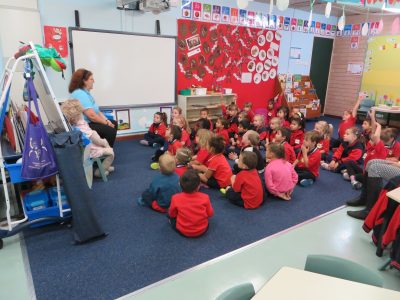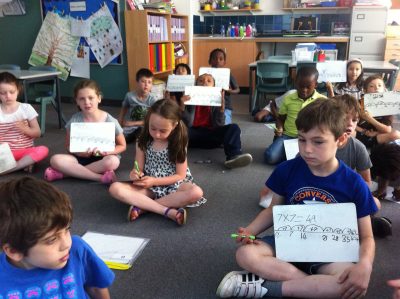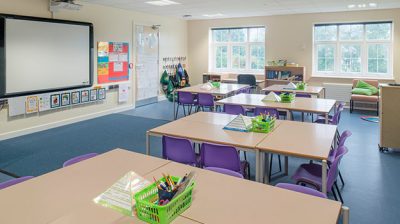Do you use a carpet sitting area in your classroom – do you physically have the space to create one and are they really worth having?
Let’s take a practical look….

Which classes and age ranges really need a carpet teaching area?
Are we just looking towards the lower end of the school and the younger children?
If you visit any Reception class then you will see carpet space in abundance with a central “meeting space” usually in front of the main class board / screen. The class in the photo above have just had their carpet area renewed and so you can see how this is positioned. However in any Reception class you will also see in evidence many rugs, but these are usually for the daily activities and not as a centralised whole class meeting point.
The use of carpet space is then generally carried through into year 1 but as the nature of the teaching content starts to change, the requirements for furniture begin to change – basically there is less space for a carpet area – although I would expect to see them in evidence at this age range.
In year 2 the changing nature of the curriculum and the demands of teaching and monitoring now become reflected in how the curriculum is taught. The need for group seating becomes a major factor and so more usual seating plans are in use. Many colleagues will still wish to use a carpet area to teach and discuss with the whole class but it will be the actual size and shape of the classroom which will decide if this is a possibility.
Carpet areas in KS2: There are no hard and fast rules about using carpet areas for key stage 2 children. There are 2 factors to consider….
- When thinking about the whole class layout is it possible to include a carpet space?
- My personal teaching style and the nature of the curriculum.

Of course one of the considerations is the “type of learning” that occurs at KS2. In Reception classes many of the learning activities can occur on carpet and rug areas around the classroom. The carpet space whilst being used for the whole class to meet and discuss things can also then be used for activities once the morning / afternoons start. This is also the case for large parts of Y1 – and as such the carpet areas are an integral part of the teaching and learning environment.
However as the nature of teaching and learning changes so the need or adaptability of a carpet area is not integral to the process and in most cases the carpet will not be used during lesson time. So we then have to ask the question:-
Can we afford to arrange / compress our classroom in order to provide a free area that will not be used very much during the day?
Do you need a carpet area or would you like a carpet area?
As we have said – in the lower age groups – primarily Rec and Y1 the use of a free carpet area is integral to the teaching and learning process (and that also includes the social elements learned from this early age). However above these age groups we are into the aspect of “I would like to include carpet / shared time in my teaching approach.”
In conversation with a colleague some time ago I was told this fact about carpet areas…if you have never heard this then it’s one for the memory bank!
“seated carpet time is generally the age of the children + 3 minutes.”
So for Reception children we are looking at a maximum of approx. 8 – 10 minutes whilst for let’s say Y4 children it would be approx 12 minutes. It’s not very long before it becomes uncomfortable and at that point children start (or have started!) to become bored!
Where do you put a carpet area?
In key stage 1 it is much easier to site than in key stage 2 and so carpet areas can more often than not be found directly in front of the board / screen with any desks arranged around this area and the room.
However for older age groups much more of the work is based around use of the teaching screen or board and so there is a need for the desk arrangements to have their focal point here. If a carpet area is to be used then it may often be found to double up around the library / reading area. Many classes will allocate a “reading space” around the class library of book area and with a little creative thinking this can be altered to double up as carpet area if required.
Some problems that occur with a carpet area in KS2:
- The carpet area if allocated will not face the board / screen so this cannot be used as a teaching aid unless the screen is pivot mounted. (you may need to use flip charts to write)
- Notes and work cannot be completed by the children sitting down – although it is possible to use small individual white boards and pens.
- As children get older it becomes more uncomfortable for them to physically sit on the floor (we often see Y6 using benches in assemblies for this reason)
- The amount of sitting time for Y5 / Y6 would be approx 15 minutes – which is not very long
- As children grow, the usable space in classrooms gets less – its just the physical element! The space needed to sit 32 Y6 children is far more than 32 Rec children for example.
 The classroom above looks to be for older children (chair/ desk sizes and also independent learning pyramids on the desks!) There is a teacher space at the front of the class which looks also to have some different carpeting as a seating area. However the classroom looks quite spacious and it is impossible to know how many children are in the class – but it does look like that may be used as a carpet area from time to time.
The classroom above looks to be for older children (chair/ desk sizes and also independent learning pyramids on the desks!) There is a teacher space at the front of the class which looks also to have some different carpeting as a seating area. However the classroom looks quite spacious and it is impossible to know how many children are in the class – but it does look like that may be used as a carpet area from time to time.

This one certainly doesn’t and it would be difficult to see any flexibility in having a choice of a carpet area!
In summing up – The use of any carpet space must be a productive addition to your teaching style and also to the curriculum. For the lower age groups it is certainly needed in respect of the content to be taught and how it is taught. There are also the vital issues associated with socialisation, friendship, sharing and even sitting and listening quietly as well as the educational elements.
As children move through the school the nature of the curriculum changes as does the requirements of how this is taught and by association teaching styles. Each teacher will have their own teaching style and approach – some will wish to continue with carpet whole class content whilst other will not…there is no right or wrong approach here.
However in recognising the changing requirements of the curriculum we must also factor in the “non essential” existence of a carpet area and its limitations both in the amount of time it can be used and also the restrictive nature of just what can be done by the children when sitting here. Have we also created a dead area that is now compressing the rest of the classroom space in order to accommodate it?
On a personal note I have never included a carpet area in any KS2 class that I have taught – I have used them in KS1 where they were certainly a positive addition.
At the end of the day the choice is yours – as with everything else in your classroom…it is an option to be considered as you build the learning environment for the children you teach.
Charles



There seems to be absolutely no regard for the health hazards and unhygenic nature of sitting on the carpeted floor after having some 30 odd children walking in off dirty, often wet and dog fouled streets. Trapesing all over the carpet and leaving all manner of dirt and germs from the soles of their shoes… schools are a breeding ground for bugs and bacteria as it is. Whilst im sure the carpets are vacoumed at the end of each day, they are not wet and dryed cleaned with disinfectants or other cleaning agents to eliminate harmful germs. Germs that are easily contracted on hands and clothing. I doubt anyone with a fair sense of hygiene awareness would allow 30+ children to walk through their carpeted house with wet, dirty shoes, possibly with traces of dog excrement on them, let alone themselves and their own children, and then proceed to sit all over the floor…. i find it incredulous that this practice prevalent in our primary schools, given the nature of the ease of contamination and spread of bacteria and germs in schools and the general environments in which we live… there are so many implications with the contracting of bacteria and germs within the school area of our childrens lives, on top of all the other potential hazards but clearly the area oulined above seems to have slipped through the net in terms of health and safety of our primary schools….
All valid points Nigel….well raised – thank you